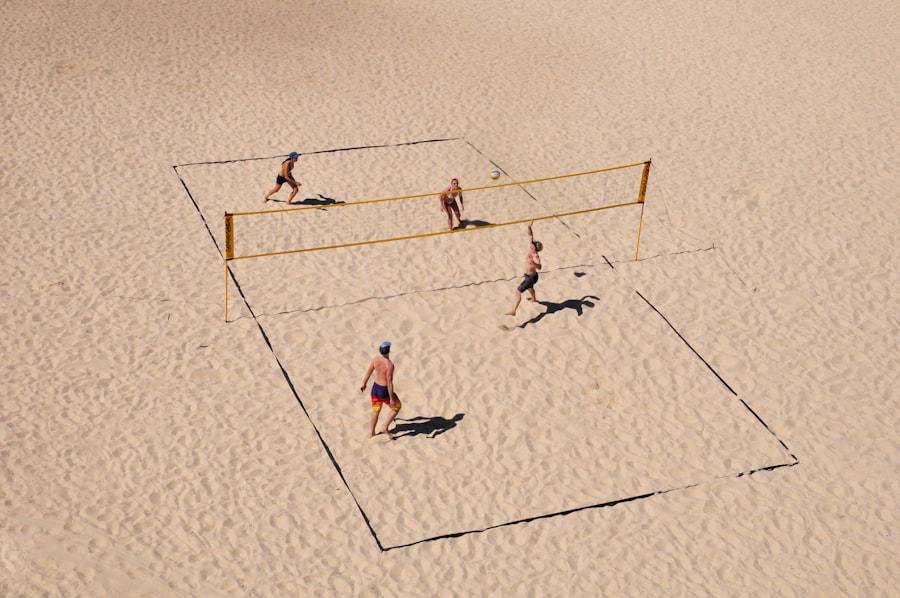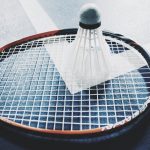Mastering the Art of Volleyball: Tips for Success
Description
Volleyball is a dynamic and fast-paced sport that has captivated millions around the globe. Originating in the United States in 1895, it has evolved into a highly competitive game played both indoors and on the beach. The fundamental objective of volleyball is to score points by sending the ball over a net and into the opponent’s court, while simultaneously preventing the opposing team from doing the same.
Each match is played in sets, with teams typically consisting of six players on the court at any given time. The game is characterized by its unique scoring system, where points can be earned on every serve, regardless of which team served. The court dimensions are standardized, measuring 18 meters long and 9 meters wide, divided by a net that stands at a height of 2.43 meters for men and 2.24 meters for women.
Understanding the layout of the court is crucial for players, as it dictates their positioning and movement during play. The game is divided into rotations, with each player taking turns serving and transitioning through different positions on the court. Familiarity with the basic rules, such as the three-hit rule, which allows each team three touches to return the ball, is essential for any aspiring volleyball player.
Additionally, players must grasp the concept of rally scoring, where a point is awarded on every serve, making every play critical to the outcome of the match.
Key Takeaways
- Volleyball is a team sport played with six players on each side, aiming to score points by grounding the ball on the opponent’s court.
- Proper technique and form are essential for successful volleyball play, including footwork, body positioning, and hand contact with the ball.
- Communication and teamwork are crucial in volleyball, with players needing to effectively communicate and work together to achieve success on the court.
- Serving and passing skills are key components of volleyball, with players needing to master various serving techniques and passing the ball accurately to teammates.
- Setting and hitting techniques are important for offensive play in volleyball, with players needing to master the art of setting up the ball for a teammate to hit and spike it over the net.
Developing Proper Technique and Form
Mastering proper technique and form is vital for success in volleyball, as it directly impacts a player’s performance and effectiveness on the court. One of the most fundamental skills in volleyball is the serve, which sets the tone for each rally. A well-executed serve can put pressure on the opposing team right from the start.
Players should focus on their stance, grip, and follow-through when serving.
In addition to serving, passing is another critical skill that requires attention to technique.
The forearm pass, or “bump,” is often used to receive serves or attacks from opponents. Players should position themselves with their feet shoulder-width apart and knees slightly bent to maintain balance. The arms should be extended in front of the body, with hands clasped together to create a solid platform for contacting the ball.
Practicing this technique repeatedly helps players develop muscle memory, allowing them to react quickly during matches. Furthermore, players should also work on their footwork to ensure they can move efficiently to get into position for both serving and passing.
Improving Communication and Teamwork

Effective communication and teamwork are cornerstones of successful volleyball play. Given that volleyball is a team sport, players must develop a strong rapport with one another to execute plays effectively. This involves not only verbal communication but also non-verbal cues that can signal intentions during a match.
For instance, players often use eye contact or hand signals to indicate who will take a particular ball or how they plan to set up an attack.
Players should engage in team-building exercises both on and off the court to foster camaraderie and understanding. Regular practice sessions provide opportunities for players to learn each other’s strengths and weaknesses, which can enhance their ability to work together during games. Additionally, establishing clear roles within the team—such as designated setters, hitters, and defensive specialists—can streamline communication and improve overall performance.
Enhancing Serving and Passing Skills
| Player | Serving Accuracy (%) | Passing Efficiency (%) |
|---|---|---|
| Player 1 | 85 | 90 |
| Player 2 | 90 | 88 |
| Player 3 | 82 | 92 |
Serving and passing are foundational skills that can significantly influence a team’s success in volleyball. A powerful serve can disrupt an opponent’s formation and create scoring opportunities. Players should practice various types of serves, including underhand, overhand, and jump serves, to keep opponents guessing.
Each type of serve requires different techniques; for example, a jump serve involves a running start and an explosive jump to hit the ball at its peak height, maximizing power and speed. Passing is equally crucial as it sets up offensive plays. Players must develop their ability to read the trajectory of incoming serves or attacks while positioning themselves accordingly.
Drills that focus on passing accuracy can help players improve their touch and control over the ball. For instance, practicing with a partner who tosses or hits balls at varying speeds and angles can enhance a player’s ability to adjust their body position and execute precise passes. Additionally, incorporating game-like scenarios during practice can help players learn how to make quick decisions under pressure.
Mastering Setting and Hitting Techniques
Setting and hitting are two of the most exciting aspects of volleyball that require precision and coordination between players. The setter plays a pivotal role in orchestrating offensive plays by delivering accurate sets to hitters. A good setter must possess excellent hand-eye coordination and an understanding of timing to ensure that hitters can make effective attacks.
Practicing different types of sets—such as high sets for outside hitters or quick sets for middle blockers—can enhance a setter’s versatility. Hitting techniques also demand attention to detail. Hitters must develop their approach, timing, and swing mechanics to maximize their effectiveness at the net.
A well-timed jump combined with an aggressive arm swing can result in powerful attacks that are difficult for defenders to block or dig. Players should practice hitting from various positions on the court to become adaptable in different game situations. Additionally, understanding how to read blockers and adjust hitting angles can give hitters a strategic advantage during matches.
Utilizing Defensive Strategies

Defensive strategies are essential for any volleyball team aiming for success on the court. A solid defense can thwart an opponent’s offensive efforts and create opportunities for counterattacks. One key aspect of defense is positioning; players must be aware of their surroundings and anticipate where the ball is likely to go based on the hitter’s approach and body language.
This requires not only individual skill but also teamwork as players must communicate effectively to cover their assigned areas. Implementing specific defensive formations can also enhance a team’s effectiveness in thwarting attacks. For example, using a “6-2” formation allows for three front-row attackers while maintaining three back-row defenders ready to receive serves or digs.
Additionally, training players in digging techniques—such as using forearm passes or rolling to get low—can improve their ability to handle powerful attacks from opponents. Regularly practicing defensive drills that simulate game scenarios can help players develop quick reflexes and decision-making skills under pressure.
Improving Physical Conditioning and Agility
Physical conditioning plays a crucial role in a volleyball player’s performance on the court. The sport demands a combination of strength, endurance, speed, and agility to navigate fast-paced rallies effectively. Incorporating strength training into a player’s routine can enhance their ability to jump higher for blocks or attacks while also improving overall stability during play.
Exercises such as squats, lunges, and plyometric drills can build leg strength essential for explosive movements. Agility training is equally important as it allows players to change direction quickly while maintaining balance. Drills that focus on lateral movement—such as cone drills or ladder exercises—can improve footwork and reaction times.
Additionally, incorporating cardiovascular conditioning through activities like running or interval training can enhance endurance levels, enabling players to maintain peak performance throughout long matches or tournaments.
Mental Preparation and Game Strategy
Mental preparation is often overlooked but is just as critical as physical training in volleyball. Players must cultivate a strong mental game to handle the pressures of competition effectively. Visualization techniques can be beneficial; athletes often imagine themselves successfully executing plays or overcoming challenges during matches.
This mental rehearsal can boost confidence levels and reduce anxiety when facing real-game situations. Developing a game strategy tailored to both individual strengths and opponent weaknesses is essential for success in volleyball. Coaches often analyze opponents’ playing styles to identify patterns or vulnerabilities that can be exploited during matches.
Players should be encouraged to adapt their strategies based on real-time observations during games; this flexibility can make all the difference in high-stakes situations where quick adjustments are necessary for victory. Engaging in discussions about game tactics during practice sessions fosters critical thinking skills among players, preparing them for various scenarios they may encounter during competition. In conclusion, mastering volleyball requires a multifaceted approach that encompasses understanding the game’s fundamentals, developing technical skills, fostering teamwork, enhancing physical conditioning, and preparing mentally for competition.
Each aspect contributes significantly to a player’s overall performance and effectiveness on the court, making it essential for aspiring athletes to dedicate time and effort across all areas of training.
If you’re a fan of volleyball, you may also be interested in checking out this article about the Grammy music awards here. It’s always fascinating to see how different forms of art and entertainment, like music and sports, can intersect and influence each other.
FAQs
What is volleyball?
Volleyball is a team sport in which two teams of six players are separated by a net. The objective is to score points by grounding the ball on the opposing team’s court.
What are the basic rules of volleyball?
The basic rules of volleyball include serving the ball over the net, rallying to keep the ball in play, and trying to score points by grounding the ball on the opposing team’s court. Each team is allowed three touches to return the ball.
What are the different types of volleyball games?
There are several variations of volleyball, including indoor volleyball, beach volleyball, and sitting volleyball. Each variation has its own set of rules and regulations.
What equipment is needed to play volleyball?
The main equipment needed to play volleyball includes a volleyball, a net, and appropriate footwear. Players also typically wear knee pads and comfortable athletic clothing.
What are the health benefits of playing volleyball?
Playing volleyball can provide numerous health benefits, including improved cardiovascular fitness, increased muscle strength and endurance, and enhanced hand-eye coordination. It also promotes teamwork and social interaction.
What are the key skills needed to excel in volleyball?
Key skills needed to excel in volleyball include serving, passing, setting, attacking, blocking, and digging. Players also need good communication and teamwork skills.





